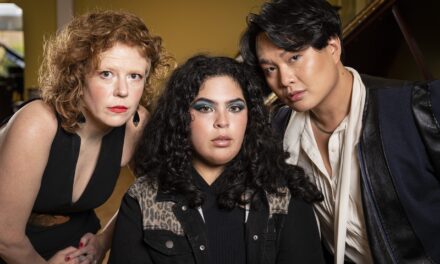The influence of Scottish folk tunes hung heavily over all three works on the season’s first concert by the Winston Salem Symphony Orchestra, given in the Stevens Center on September 14. The house seemed fuller than was the case last spring. Many were on hand to hear the opening program of the 25th and final season of Music Director Peter Perret.
Returning for her fourth appearance with the orchestra, Korean violin virtuoso Livia Sohn gave a very individual and sophisticated interpretation of Max Bruch’s too seldom performed Scottish Fantasy, Op. 46. Its full title is “Fantasy for Violin and Orchestra with Harp, Freely Using Scottish Folk Melodies”; it was composed in the winter of 1879-80 and premiered by Pablo de Saraste. Perret, in brief comments from the stage, said that the composer got his folk melodies from books in the public library. Sohn, playing a violin by J. B. Guadagnini dated 1774, displayed a warm tone, wide dynamic range, and precise intonation in the highest registers and fastest passages. Her tone projected well throughout its range and, in the distinctive opening passages, she managed to put forth one of the most delicate pianissimo entrances I have ever heard. Stevens Center has fine acoustics for strings in particular and this contributed to a sense of fullness from Sohn and the orchestra, which Perret reined in and managed perfectly in support of the never-covered soloist. Unlike many young rising stars, the mid-twenty-ish Sohn listened like a chamber musician to her orchestral colleagues, including Kathryn Levy, flute, John Ellis, oboe, Kelly Burke, clarinet, Concertmaster Corine Brower, and Helen Rifas, harp. The horn section was in great form throughout the concert, and the string sections played with tight ensemble and a good sheen. Several exposed portions revealed some outstanding sound from the viola and cello sections.
Perret recounted how Sohn first came to appear with the orchestra when she was only eleven tears old, replacing an indisposed older soloist on only two days’ notice. The conductor had called her teacher, Dorothy Delay, who told him she had three equally qualified candidates, one eleven, one sixteen, and one twenty years old. He picked the youngest of the three. For her first WSSO concert, she played the Mendelssohn Concerto, the second brought the Khatchaturian, and the third, the Sibelius.
Sporting what appeared a large circular tattoo on her right arm, Sohn explained that members of the Celtic band Gaelic Storm (famous as a result of the movie Titanic , the group shared the previous night’s pops program) had given her a phony tattoo that was supposed to wash off easily. Too late she read the label that warned it lasted three days.
Perret opened the concert with a splendid and very classical reading of Mendelssohn’s well-known Symphony No. 3 in A Minor, Op. 56 (Scottish). Many opportunities to “go over the top” were eschewed in favor of a balanced interpretation that fitted each continuously played movement into a view of the whole work. All sections of the orchestra were in top form; in addition to the already named woodwinds and strings, Frederick Bergstone and his horn colleagues were outstanding in various solos and as a unified ensemble of five. Perret’s dynamic choices and phrasing were ideal.
An unusual work brought the concert to a rousing or carousing ending. Noted conductor and composer Peter Maxwell Davies wrote “An Orkney Wedding, with Sunrise” in 1985 for the Boston Pops and John Williams. I well remember a PBS broadcast of a performance that was marred by a projection of thespians presenting the action better described in the score. Gerhardt Zimmermann and the NC Symphony presented it in the late 1980s but much of the score’s humor was lost in the cavernous acoustics of Raleigh’s Memorial Auditorium. The score begins with a short depiction of the stormy weather outside the house. A processional enters, led by an oboe (Ellis) and followed in turn by a clarinet (Burke), a bassoon (Mark Popkin), and other woodwinds, supported by pizzicato strings. The “band” tunes up and becomes increasingly inebriated – portrayed by missed beats, entrances, etc. During the “walk” home through the night there is a delicious lurching figure played by the trombones. The sunrise is depicted by the entrance of a bagpiper in full highland regalia; in Winston-Salem, Eben Mann marched down the left aisle and stood blowing that ill wind better than most. Perret made the best case for this work that I have heard yet.
In a move long overdue, the program notes for the entire 2003-4 season are in one booklet, a step taken by the NCS, the GSO, and the EMF decades ago.











